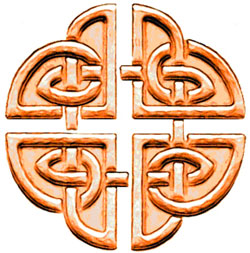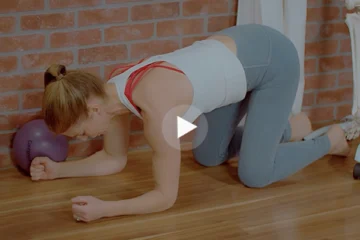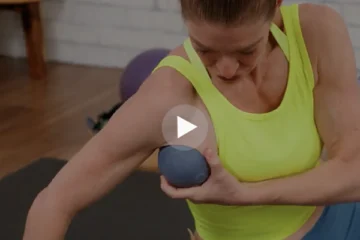
In Yoga Tune Up® we’re encouraged to look for the less obvious reasons why a muscle or joint might act the way it does. Human anatomy is at once complicated, beautiful and mind-bogglingly intertwined. Rarely does it seem that the site of discomfort is actually the source of the problem. But if you can loosen just one tiny piece of the knot, keep following the thread—and you’ll probably unravel your client’s pain.

Consider a woman who came to me complaining of sciatica on her left side. She had been in and out of physical therapy for years, but it never provided long-lasting relief. A few sessions with the YTU Therapy Balls, some pelvic primers and the leg stretch series relieved the searing leg pain she has been experiencing, but now she noticed the entire left side of her body, shoulder to thigh, felt tight. Clearly while we had relieved the majority of her discomfort, we hadn’t solved the problem.
We used the Therapy Balls on her quadratus lumborum. The intense sensation she felt on the front side of her body was a perfect reflection of the QL/psoas connection at the 12th thoracic/upper lumbar vertebrae. What didn’t make sense, however, was that given the QL and psoas’ connection to the respiratory diaphragm, she was breathing too shallowly for someone feeling the work to the extent she claimed.
Perhaps the issue was lodged further up the body. The lower trapezius also connects at T-12. What if the lower traps were tugging on the mid traps, which were tugging on accessory respiratory muscles like the rhomboids, upper trapezius and pecs? Since my client mentioned her shoulder hurt, we changed tactics and moved the balls to her upper back, rotator cuff and clavicular area, adding some PNFs and ‘shazam’ stretches like Holy Cow at the Trough. She ‘oohed’ and ‘ahhed’ about how nice all of this felt, but her breath deepened only slightly.
Stumped, we returned to her mid-section—this time doing static yogi leg lifts to stretch her psoas eccentrically (lengthening the muscle while contracting it). With her left leg hovering an inch off the mat, she inhaled so deeply and dramatically it surprised us both. And then came the woooosh of her body releasing from her shoulder to her thigh (see? they are connected!). It was at this point my client mentioned she had broken her sternum some time ago, but never received respitory therapy as part of her rehabilitation. She hadn’t taken a deep breath in years and had never noticed until now. But neither had she noticed any pain at the site of the break—only the sciatica which brought her to me.
How the human body processes and presents injury can be frustrating for client and practitioner alike. It is unclear exactly how my client’s body dealt with her broken sternum. What is clear is that as her sternum healed, it kicked off a chain reaction in her body that wound its way though her chest, shoulder, back, abdominal and possibly gluteal muscles, ultimately showing up as sciatic pain—which is now, happily, a distant memory.
We finished that session with a few rounds of uddihyana bandha—they literally blew her mind and mine, as the body’s quirky, circuitous muscle connections and pain unwound themselves in just one breath.
Learn more about our Yoga Tune Up Teacher Training.
Find a Yoga Tune Up class, workshop or retreat near you.
Watch our videos on YouTube.












Thanks for this incredible story! It was really interesting to read about your experience with this client and how you used your knowledge about muscles attachments and joint relationships like a detective to resolve the mystery. I’m learning so much about how the body is interconnected in my YTU training, but its one thing to study the anatomy books and theorize, and another to see this work play out in real and significant ways in people’s lives, healing their bodies and eliminating pain.
I’m curious about your thought process that brought you up to the shoulder. You write that your student wasn’t breathing deeply enough to feel what she was claiming to … is this when you shifted to thinking the issue was with the breath and not with the QL/psoas, which moved you towards the traps/shoulders?
These kinds of stories make me well up. This is exactly why I’m on this path. Thank you so much for sharing this experinence, and what I love more than anything, (what I’m getting out of this story) is you followed the path of pain, noticing things along the way, Connecting them together.
I also connect with your bio: I know that I am so inspired to help others out of pain because of my own pain in my body, and my desire to unwind the mysteries. So stoked to be a part of this community!
What an incredible teacher you are! How insightful of you to keep trying new things. I love yoga tune ups creative and open minded approach to the body. Thanks for sharing.
What a great story! You and your client were students of her body together, peeling away the layers of the mystery. It is an inspiring lesson to all of us who want to help others solve their pain and physical dysfunction.
Thanks.
Wow what an incredible story. I am currently struggling with pain in my hamstrings, but the pain extends all the way up my right side. I feel pain in my ribs, my shoulder blade, neck and shoulder all on the right side. I am currently working with a PT and I am hoping that with my new YTU knowledge I will be able to solve my bodies mystery. Thank you for sharing this story as it has given me some hope!
This is an inspiring story. It is awesome to work through the intricacies of the human body and find solutions to pain.
It never ceases to amaze me how maze like it can be to navigate pain sensations through the body. As a facilitator to other people’s journey through healing it can be quite intimidating to say to our clients “I don’t know why you feel that there, let’s explore some other area that might be connected”. Kudos to you and the woman you worked with for being open to the exploration.
It is so interestesing how the body is so interconnected, we so often isolate an issue to one part of the body. Just today in YTU training we were looking at how the psoas and the QL are connected to the fibers of the diaphragm. Though I am sure I’ve seen this before in cadaver labs, I never made the connection between hip flexors and breath. I will definitely try to take a more clobal approach to assessing proper excercises for a different ailments.
Really great story. You have put pieces of the puzzle and then put them together. As a nurse and acupuncturist it’s amazing what people don’t tell you because they didn’t think it was that important, it happened so long ago or that “but that’s not the problem I’m having now” A wonderful teacher of mine once said that all traumas, emotional or physical are stored somewhere in the body. To track down where that trauma is held is like CSI without the dead body.
This is such a great example of why it’s important to really explore your whole history when there’s pain somewhere. I know it seems counter-intuitive, but just because the knee hurts doesn’t mean there’s something wrong with it! The culprit is very likely somewhere further down or further up in the chain. I’ve had knee and foot problems ever since I broke my tail bone twice in one year. Ugh. I’m finally learning now, 15 years of flare-ups later, that when my hips are able to get into their full range of movement and are stable (which is hard for me!) the feet and knees feel totally fine. Of course there’s always more to it than that, like my own habitual way of working my hamstrings and not my quads. Or my way of “protecting” my sore feet by tiptoeing around. I’m pretty sure it goes on!
Fantastic! Thanks so much for sharing this unraveling journey you and your student took! It is fascinating how clever our bodies are at winding, and unwinding themselves. It reminds me of one of my teachers constant reminders to me as a bodyworker, “wherever you think it is, it ain’t.”
If their is a kink in one part of the kinetic chain, it will effect the entire chain in some way. I had a biomechanics teacher say it’s as if you have a very tight sweater on your whole body and watch what happens when you pull a small pinch away from the surface.
Our ‘sweater” is woven inside, outside, across, around and throughout. Your client is a perfect example of that.
Unraveling the Gordian Knot, or How the Shoulder Bone Really Is Connected To the Thigh Bone by Christine Jablonski
I am using this article as inspiration here is why:
I am in the beginning stages of possibly taking on a private client. Her Glut min is haning on for dear life – She is seeing a sports medicine expert (so good for her) the types of therapy she was perscribed were:
Prolotherapy to the sacroiliac joints
IMS needling to the posterior fibres of glut med and the entire body of glut min.
He also perscribed her hubby to push down on her iliac crest (while she lays on her side) after a long day.
for her only perscribed her to do a “clam” excersise (while on her side) feet/ankles together and opening through the knees which is external rotation through the hip contracting the muscle.
I researched all of these and they seem to be intensive but a wonderful variety with out surgery! Encouraging the body to heal itself and I am convinced that YTU is the perfect compliment… (i would humbley appreciate any feed back)
I saw her once before she went for further treatment and received this information. I jotted down bridge waves, appanasana and a milder version of revolved abdobminal pose version .5 (extending the leg) then with the balls we massaged through Piriformis, and all glut muscles, Tensor Facia Latta, and into her IT band. It appers to me to schedule her more time and include: QL, and (since he asked her to concentrate on pushing her Iliac Crest down?) Also from this article it for sure do her good to continue to rub out through Traps, Shoulders, and Clavical. I have been adimate that her Professional check into my suggestions and take a moment to visit Yoga Tune Up website – I hope he does and I hope this is a good relationship for my possible future client and my budding skills with YTU. Don’t worrie Im taking many notes. Thanks for the inspiration – Thoughts anyone???
What a fabulous example of how it takes a really experienced therapist to tune in to a client’s body- accounting for specifics of the individual case, rather than generalized prescriptions and diagnoses. It’s also a great opportunity to be reminded how critical our breathing is to our overall well-being and that even without a broken sternum, it’s likely many painful symptoms can be eased with some deeper breath work.
Our body if like a line of dominoes, if we can straighten them out they will all stand tall! thanks for the reminder of how connected all pieces are.
It is important to remember that the muscles in the body do not function in isolation. Everything is connected! This case study is a great example of this.
This is so inspiring. It reinforces the idea that the body can actually heal itself with a skilled, intelligent touch to help the process along. Nice work. Otherwise, we’re doomed to grow old constantly reaching for the next pill and the next prescription. I’ll take the TuneUp instead.
I agree with Laura and Anh Chi — this is a fantastic practical application of anatomical knowledge, showing that the more we all know about the relationships in the body, the better we can help our students and ourselves. It is fascinating how all of us tend to block out past injuries that leave internal and external scar tissue. I imagine we all get used to compensating around the injured sites to the point where we forget that we moved or felt any other way.
thanks christine for this great case-study. i love how you created such a trusting relationship with your client and that the two of you were able, through this relationship and dialogue, by trial and error, unwind and unlock her pain. very inspiring!
A wonderful puzzle solved and you did a great job of exploring with your client to piece it all together. I had a similar whooshing experience while receiving myofascial therapy on my head–the sound and sensation of the spontanteous breath release so surprised me. For a few moments I didn’t believe that the sound had come from me.
It is always interesting when a student alerts you to a body issue they are having and after weeks of suggestions and explorations with them they suddenly remember to tell you about a massive bone break they had in the past, or my favorite, oh yeah, I have a metal rod in that limb.
I often feel the same way, wondering where exactly the issue is that is causing the pain that seems to migrate from one spot to another very close by. I find myself thinking and sometimes saying out loud ‘if only I could remove my skin and exactly locate which muscle, ligament or tendon it is. The search continues as my knowledge grows, it’s like a mystery novel each step of the way. I do know the YTU training is getting my closer to it every day!
Thank you sharing your wonderful experience! I love the fact you continued to delve deeper and deeper until finding the ultimate issue, like a detective of sorts. So many times clients forget specifics clues to their issues until hitting that break though. I look forward to continue being a detective in my own body & urging others to do the same. What a gift to bring full breath after such a long a time 🙂
This client presentation is an excellent example of a lot of ”stuff” people bring into class with them. However, not everyone will admit past or present injuries, physical or emotional imbalances. Many times, people are not even aware of their stuff and the domino effect it has on their body. The YTU method of unraveling and releasing what is stuck and strengthening the weak muscles assists the body in creating new muscle patterns which promote health and healing.
What a facinating story. Its interesting that many people to not delve deeper into the body and just look to the areas of pain. The body adapts to untreated injury and that pain winds its way throughout the body and as Christine explains the Gordian Knot there is no beginning or end: fibers are continously looped into each other, as in the human body. I am celebrating YTU teachers that look deeper into the body for those less than obvious reasons for pain and with the amazing knowledge and tools they posess begin to loosen and eventually unwind that knot.The breath is an amazing tool in that box so taken for granted as did this client, its interesting she never mentioned the sternum and her breathing until they began to untie knots.
I am so fascinated by the adaptability of the human body, I am inspired to deepen my fluency with the muscles and connective tissue in relation to yoga poses and one day have the ability to unravel this type of puzzle. My first blast of this type of connection was when receiving an adjustment from the osteopath. I was complaining of tight adducters and hip flexor on my right leg. I expected him to work at that area and relieve the tension. To my surprise, he worked on my lower back. After a few minutes i felt flooding relief. I asked how that had happened and he explained that my kidney was out of alignment. The connective tissue was pulling the at the origin of the hip muscles. I was instantly a firm believe in the fascial chain and will continue to work on this path.
I am continuously amazed at how complicated the body is and how an issue in one area of the body is the beggining to the end of a trail of hidden clues left behind from old traumas. Our bodies abilities to store trauma and attempt to heal or compensate for a trauma is genius in itself but with our conscious awareness and understanding of the map of our body and everything else that encompasses us and what we are doing is so empowering in our own healing.
This is such a great story! Your experience really shows us how the whole body is connected, and that the location of pain in the body is not necessarily an indication of injury at that location. So many people fail to explore deeper. This reminds me of how people often overlook the signs of having a heart attack, because they experience symptoms elsewhere, such as pain in the upper arm or shortness of breath. Yoga is so beneficial because it teaches us to bring awareness to our bodies and truly sense how we feel as we practice. Some teachers have told me that the poses we find most challenging are often the ones we most need to practice. I think this can be true in that it allows us to explore our shortcomings and notice where we might need to bring our awareness. And from there, we continue to look deeper – perhaps one challenging action leads you to discover a new connection you hadn’t previously accessed. This is a great lesson in perseverance to bring the entire body back into balance.
Wow- what a great, informative article Christine! To be able to have the tools to literally excavate the area of pain is a priceless skill. From Gil Hedley’s anatomy videos we learned that nearly every muscle and tissue are connected in the body and a pain in one area of the body could be a result of an injury in another as the body overtime overcompensates. And using pranayama as a tool to literally breathe life force back into our bodies- just as this woman did when she finally took a deep breath is crucial. I believe that these tools of integrated anatomy we are learning will lead to a new therapy movement of the future. I know many people that sing the praises of theraputic yoga when physical therapy wasn’t producing results.
Restructuring the body’s many interconnected pieces like a puzzle, with even greater skill and precision than a surgeon! And all without seeing or knowing the root issue. This is the most rewarding work!
The human body is fascinating!